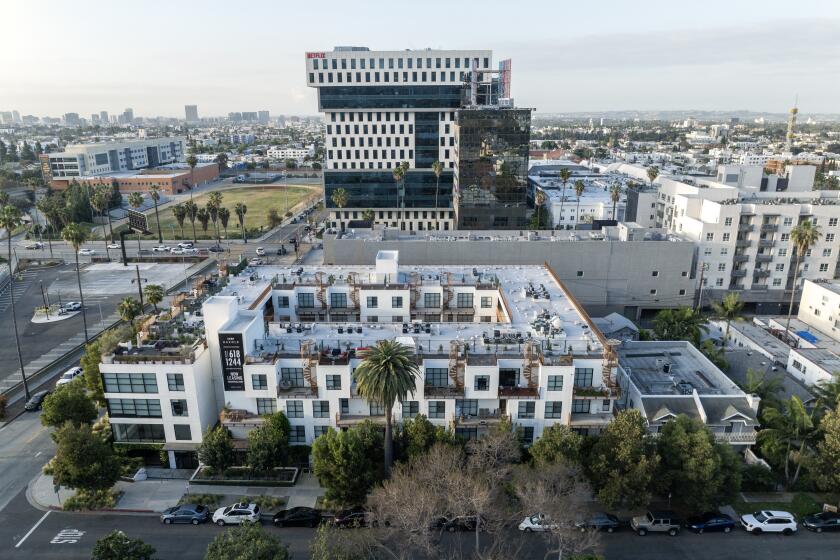Santa Barbara Couple Get a Lot of Home on Tiny Lot
When a local dry-cleaner and his wife finally move into their new four-story home, they’ll have a convenient downtown location, a drop-dead view, and plenty of room to breathe -- as long as they don’t puff out their cheeks too much.
Their entire spread will be built on a lot of 20 feet by 20 feet -- an area about the size of a deluxe room at the Four Seasons Biltmore just down the highway.
Last week, the Santa Barbara City Council unanimously approved plans for the whimsical, Spanish-style tower. Neil Ablitt, owner of the pint-sized parcel, was jubilant about the council’s action, particularly because the city’s Planning Commission had turned him down by a 4-3 vote in February.
“This is a work of art, an asset to the community and a legacy to our grandchildren,” he said. “We don’t need big houses, we don’t need big yards and we don’t need to tear up farmland.”
Down an alley behind a pizza place, a Mexican restaurant and a metal-plating company on State Street, Ablitt’s patch of downtown real estate is about one-fifteenth the size of a typical new-home lot in Santa Barbara. Fifty-seven of Ablitt’s lots could fit inside the main house of Oprah Winfrey’s estate in Montecito.
With no room to stretch out, Ablitt and his wife, Suzanne, opted for stretching up. Their first floor will be a one-car garage. The second floor will be a bedroom, the third a kitchen, and the fourth a living room. On their rooftop patio, they’ll take in a panoramic vista of mountains and sea as they gaze down upon the family dry-cleaning store half a block away.
“My biggest concern is noise,” said Ablitt, 61, whose dream tower will sit nearly cheek-to-cheek with a dance club called Velvet Jones. “But since I’m building downtown, I don’t have any right to complain.”
Granting the Ablitts a number of exceptions to city building guidelines, council members pointed out that the city’s 47-year-old zoning code didn’t anticipate sky-high land prices or a need for downtown housing. Besides, some simply liked the idea of an eccentric home on an oddball chunk of land.
“We’re renowned for our Spanish-Mediterranean architecture, but when you talk to natives, that’s not the thing they love about the city,” said Councilman Brian Barnwell, a real estate appraiser and general contractor. “What they love is the little, quirky, down-the-alleyway, around-the-corner, who-knew-it-was-there type of thing.”
Not everyone was so taken with the idea.
“It sits too close to our property,” said Kay Morter, the general manager of the Holiday Inn Express/Hotel Virginia, a recently restored hotel whose parking lot neighbors the Ablitts’ home site. “It towers over our buildings and blocks some of our mountain views. And it’s kind of funny-looking.”
Planning Commissioner Bill Mahan said the lot was simply too small.
“It’s a wonderful, beautiful building, but this is a house with no setbacks,” said Mahan, an architect. “Generally speaking, the zoning ordinance requires setbacks around residences -- for landscaping, to keep you apart from your neighbors and your neighbors from you. It’s just a good idea.”
But requiring a yard on the tiny lot would have squeezed out the house.
“Do the math,” Ablitt said. “We could have built maybe a flagpole.”
Interviewed via cellphone, Ablitt was laying away provisions in his 37-foot sailboat as he and his wife headed for a Mexican fishing village called Puerto Magdalena. From time to time, they haul down supplies of food, used clothing, and even computers for friends they’ve made there.
The couple have lived aboard their boat for 15 years. Most of the time they were moored in Santa Barbara Harbor and tended to their dry-cleaning business. Now, though, they are more or less retired, and their daughter, Sasha, has taken over the store.
In 1984, Ablitt was just beginning to build his business, and the last thing he needed was a patch of useless land. But he thought the city might condemn the building in which his dry-cleaning business was located to put in a parking lot. The best way to thwart that would be to sit on a local parking board -- and Ablitt thought his chances of doing that would be boosted if he were a landowner.
The threatened parking garage never came to pass. Ablitt never joined the parking board. The property -- which Ablitt thinks cost him something like $8,000 -- remained useless.
But in recent years, the Ablitts have wanted to be closer to family and anchor themselves on dry land. With the median home price topping $900,000 in Santa Barbara, life on a large parking space, down the alleyway and around the corner from the family business, looked pretty good.
One day, Ablitt mentioned his lot in life to Jeff Shelton, the architect who designed an 18-unit condominium project next to the dry-cleaning shop. Festooned with billowing “rugs” of tile, the building is part Seville and part Dr. Seuss, and has won several architectural awards.
“It’s an incredibly beautiful structure,” Ablitt said. “It’s a house of whimsy.”
Overnight, Shelton drew up a rough plan. At the time, he didn’t know about a 6-foot-wide, four-century-old landmark home in Amsterdam, or even about the 9-foot-wide Long Beach house that was once featured in Ripley’s Believe It or Not as “America’s Thinnest Home.” But no matter; the Ablitts’ lot, he said, left little room for architectural noodling. “It wasn’t very complicated,” he said. “After getting the car and the stairs in there, I really didn’t have to make a lot of choices.”
Shelton is trying to squeeze an elevator into his design, but his clients said it wouldn’t be crucial. Life on a boat has accustomed them to tight spaces and plenty of trips up and down the companionway.
The Ablitts’ house will measure 19 feet by 19 feet at the base, with a 1-foot margin all around for what Shelton called “earthquake sway.” The living room on the top floor will be just 11 feet by 11 feet.
“You don’t need much more than that for a couch,” Shelton said. In fact, he added, you don’t need much more than a 20-by-20 lot for a home.
“Sometimes more constraints make a thing easier,” he said. “You just get right to the point.”






